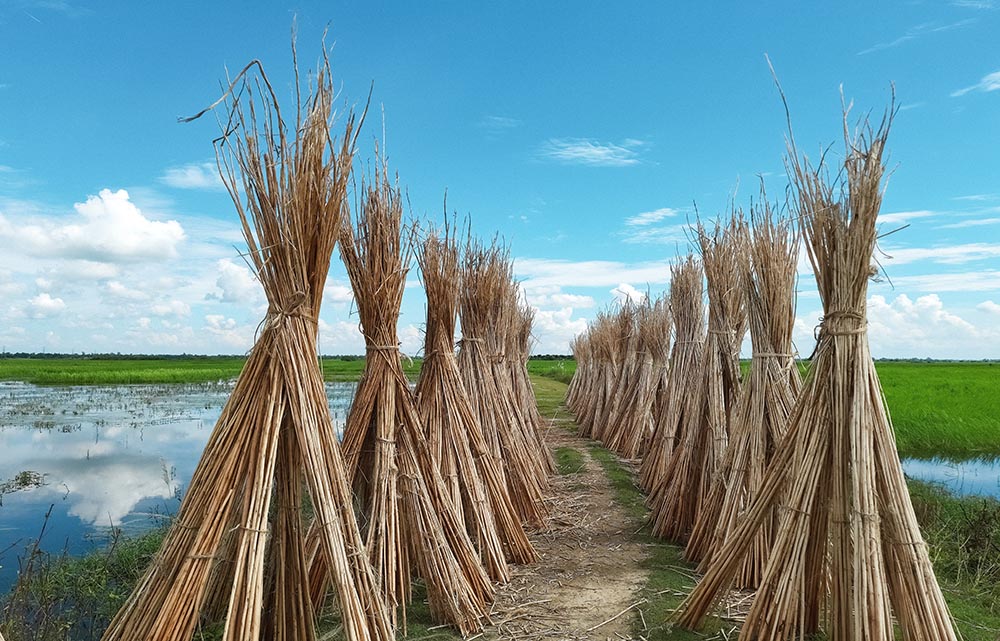Jute is a versatile and eco-friendly natural fiber derived from the outer stem and skin of the jute plant. It is primarily grown in tropical regions, with Bangladesh and India being the major producers. Jute plants thrive in warm climates, abundant rainfall, and well-drained soil.
Jute offers several environmental benefits that make it a great choice for sustainable practices. Firstly, jute is biodegradable. It naturally decomposes, minimizing its impact on the environment. Unlike synthetic materials, which can persist in landfills for extended periods, jute products break down organically, reducing waste and pollution.
Another significant environmental advantage of jute is its carbon sequestration properties. As jute plants grow, they absorb carbon dioxide from the atmosphere through photosynthesis. This process helps mitigate climate change by reducing greenhouse gas emissions. By utilizing jute products, businesses and individuals can contribute to carbon footprint reduction and combat global warming.
Jute cultivation also supports soil conservation. The extensive root system of jute plants helps prevent soil erosion by binding the soil particles together. (For more information about Jute and how it can be used as a biodegradable Erosion Control visit the Golden Gate National Parks Conservatory Website.) This feature is crucial in regions affected by deforestation and unsustainable agricultural practices that lead to soil degradation. By promoting jute cultivation, we can enhance soil fertility and protect valuable arable land.
Additionally, jute is a renewable resource with a short cultivation cycle. It grows quickly, reaching maturity within four to six months, allowing for multiple harvests in a year. This rapid growth rate makes jute an economically viable and sustainable alternative to other fibers.
Moreover, jute cultivation requires minimal pesticide and fertilizer use compared to other crops, reducing chemical pollution and preserving water quality. It also requires less water compared to cotton production, making it a more water-efficient choice.
In summary, jute is a remarkable natural fiber with numerous environmental benefits. Its biodegradability, carbon sequestration properties, soil conservation, renewability, and lower resource requirements make it an excellent choice for sustainable practices. By embracing jute products, we can promote a greener future and contribute to a healthier planet.
Environmental Benefits of Jute Bags:
- Biodegradability: One of the most significant environmental advantages of jute bags is their biodegradability. Jute fibers break down naturally when exposed to environmental elements, reducing the long-term burden on landfills and oceans.
- Renewable and Sustainable: Jute is a highly sustainable crop. Its cultivation requires minimal pesticide and fertilizer use compared to other crops. Furthermore, jute plants contribute to soil fertility, as their leaves fall to the ground and enrich the soil with organic matter.
- Carbon Footprint: Jute plants act as carbon sinks, absorbing CO2 from the atmosphere and reducing greenhouse gas emissions. The production of jute bags also generates relatively low carbon emissions compared to synthetic alternatives.
- Reusability: Jute bags are incredibly durable, capable of withstanding heavy loads. They can be reused multiple times, reducing the need for single-use plastic bags and promoting a more sustainable shopping culture.
- Non-toxic and Safe: Unlike plastic bags, jute bags do not release harmful chemicals when in contact with food or other items. They are a safe and eco-friendly option for carrying groceries, clothing, and everyday essentials.
- Jute is undoubtedly an eco-friendly alternative to conventional materials, and jute bags exemplify its environmental benefits. These bags combine style, durability, and sustainability, making them an excellent choice for environmentally conscious individuals. By opting for jute bags, we can actively contribute to reducing plastic waste, protecting our natural resources, and promoting a greener future.
Photo by Ferdous Hasan: https://www.pexels.com/photo/brown-jute-under-the-blue-sky-14251547/



